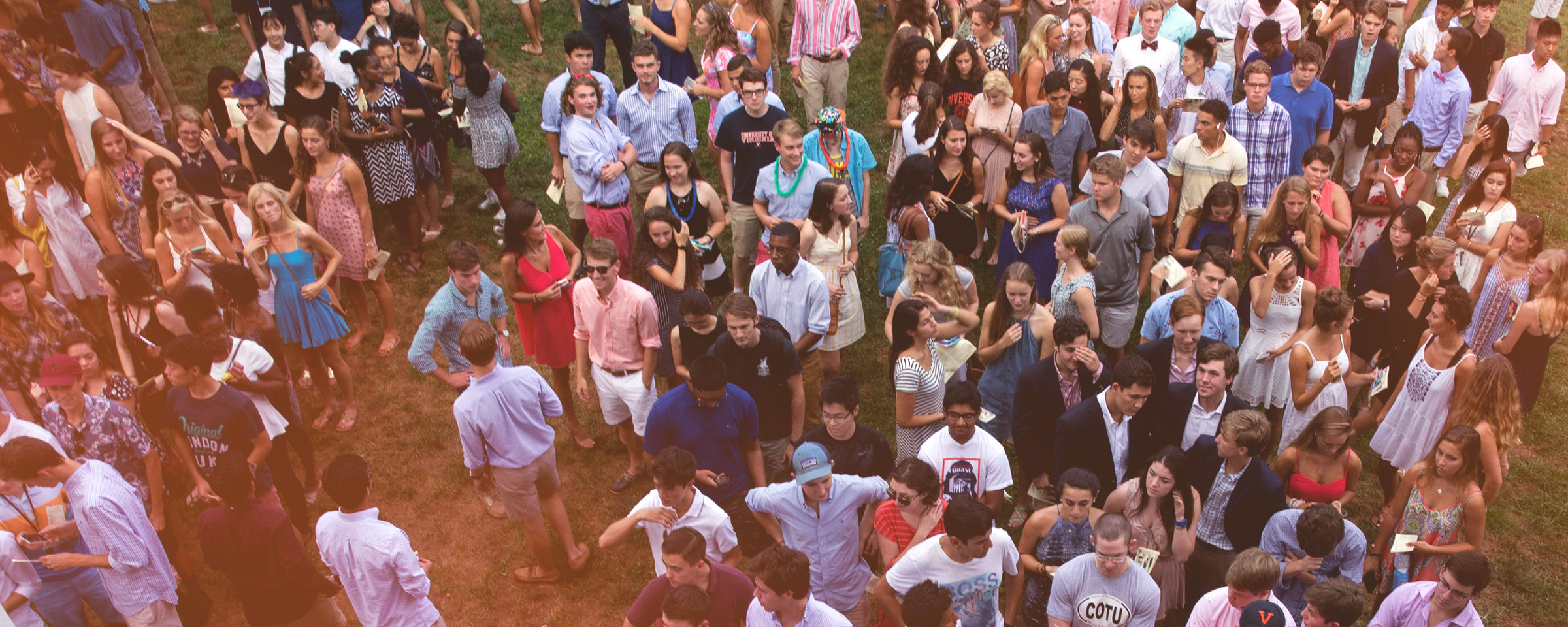Members of the University of Virginia’s entering first-year class are arriving at a pivotal moment for the University and the nation.
In their four years on Grounds, the Class of 2020 will take the first courses held in the newly renovated Rotunda, witness a historic presidential election and celebrate UVA’s bicentennial.
In the midst of all the excitement, each member of the new class is sure to leave his or her own unique mark on Grounds. They’ve already set an impressive standard for academic excellence: 88 percent graduated in the top 10 percent of their high school class and they earned an average SAT score of 1,346.
“We are tremendously proud of this class and we can’t wait to see what they accomplish in their four years on Grounds,” UVA Dean of Admission Gregory Roberts said. “The Class of 2020 is among the most diverse, interesting and talented to ever enroll at UVA. This group of first-year and transfer students will make an impact, both here on Grounds and in the world.”
The Class of 2020 boasts a total of 3,690 members, with 2,465 Virginians and 1,225 students from out of state. Like their second- and third-year peers, this year’s class represents one of the largest in UVA history, and its members come from wide range of backgrounds.
The University of Virginia Magazine recently used admission data to create a detailed set of visualizations on the incoming class and how it compares to past years. See the full story on the magazine’s site. Here's one example:
Enrollment by race
SOURCE: George Stovall, Office of Institutional Assessment and Studies, via UVA Magazine
EDITOR'S NOTE ON THE DATA
The number of first-year students from ethnic and racial minority groups has increased from 26.5 percent to 31.9 percent in last five years with more than 1,175 members of the Class of 2020 self-identifying as minorities. The graphic above depicts this rising trend using data accurate as of Aug. 18.
Within the new class, there was also an increase in the number of students who self-identified as African-American, Asian or Hispanic over the previous year. In past years, students were only given the opportunity to list themselves in one racial category, but since 2009 students of mixed race or ethnicity have been able to report more than one category and are encouraged to do so. This year, 145 members of the first-year class identified as multi-race.
Additionally, the Class of 2020 represents a fusion of different cultures, with students from all over the United States and the world. They include 173 international students from 45 different countries, including arrivals from Thailand, Morocco, Brazil, Turkey, Finland and India.
“Diversity is tremendously important to the University and we work to continue expanding it every year,” Roberts said. “It enriches each class and adds to the dynamic learning environment.”
Like the class that came before them, this group of first-years also contains a slightly higher number of females. Women make up approximately 54 percent of first-years.
As part of its continuing commitment to provide an affordable, world-class education, UVA once again offered aid packages to meet 100 percent of every new student’s demonstrated financial need and provided financial assistance to 1,255 students through its financial aid program, AccessUVA. The new class also includes 409 federal Pell Grant recipients, and includes more than 400 first-generation college students.
New students will begin to build their home at UVA over the next few months, finding those courses and activities that will define their time here. As the Class of 2020 carves out its niche, the deeds of its members will soon outshine the limitless potential they’ve brought to Grounds.
“During a time when the country is divided on many issues, we can look to students like these to help us come together and find solutions and common ground,” Roberts said. “They are an impressive bunch and we are honored to welcome them to UVA.”
NOTE: Prior to 2009, students were only given the opportunity to list themselves in one racial category. Starting in 2009:
Students of mixed race/ethnicity were encouraged to report their race/ethnicity in more than one category.
The Asian/Pacific Islander category was split into two new categories: (1) Asian, and (2) Native Hawaiian or other Pacific Islander.
Hispanic was considered to be an ethnicity, separate from the other racial categories.
The University is required to report students in only one category in order to avoid duplication. Trumping rules are used to determine in which categories to count students of mixed race/ethnicity:
Any student who is a non-resident alien foreign student is counted as non-resident, no matter his or her race or ethnicity. (This was not a new rule in 2009.)
A student who did not give any race/ethnicity information is designated “Unknown.”
Any other student who is of Hispanic ethnicity is counted in the Hispanic category, no matter what other race he or she may have reported.
Any student who listed more than one race, and is not of Hispanic ethnicity, is counted in a new category called “multiple race.”
All remaining students, those who chose only one racial category (and are not of Hispanic ethnicity), are put into that category.
Media Contact
Article Information
August 24, 2016
/content/2020-vision-look-inside-uvas-newest-class-0

